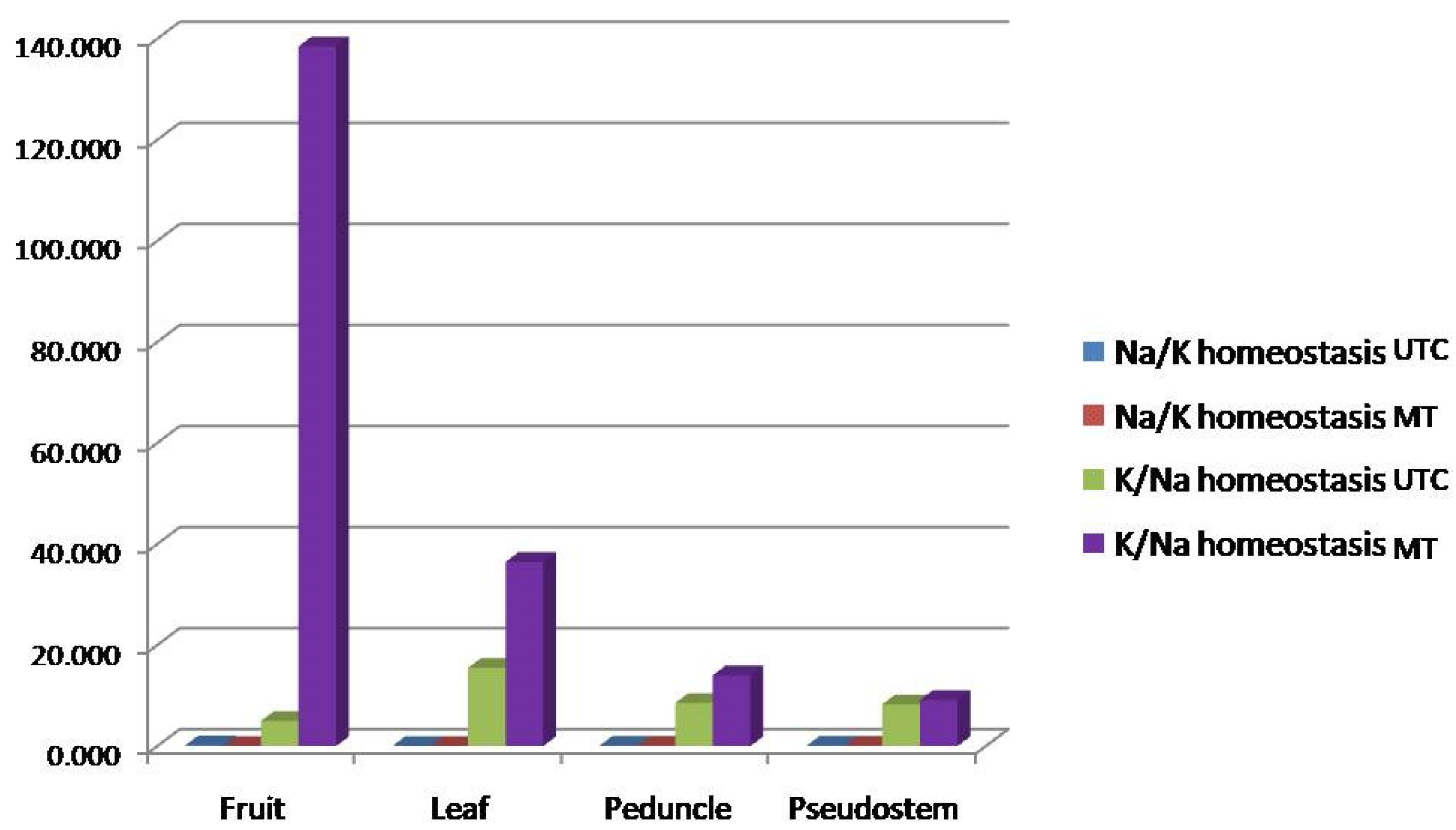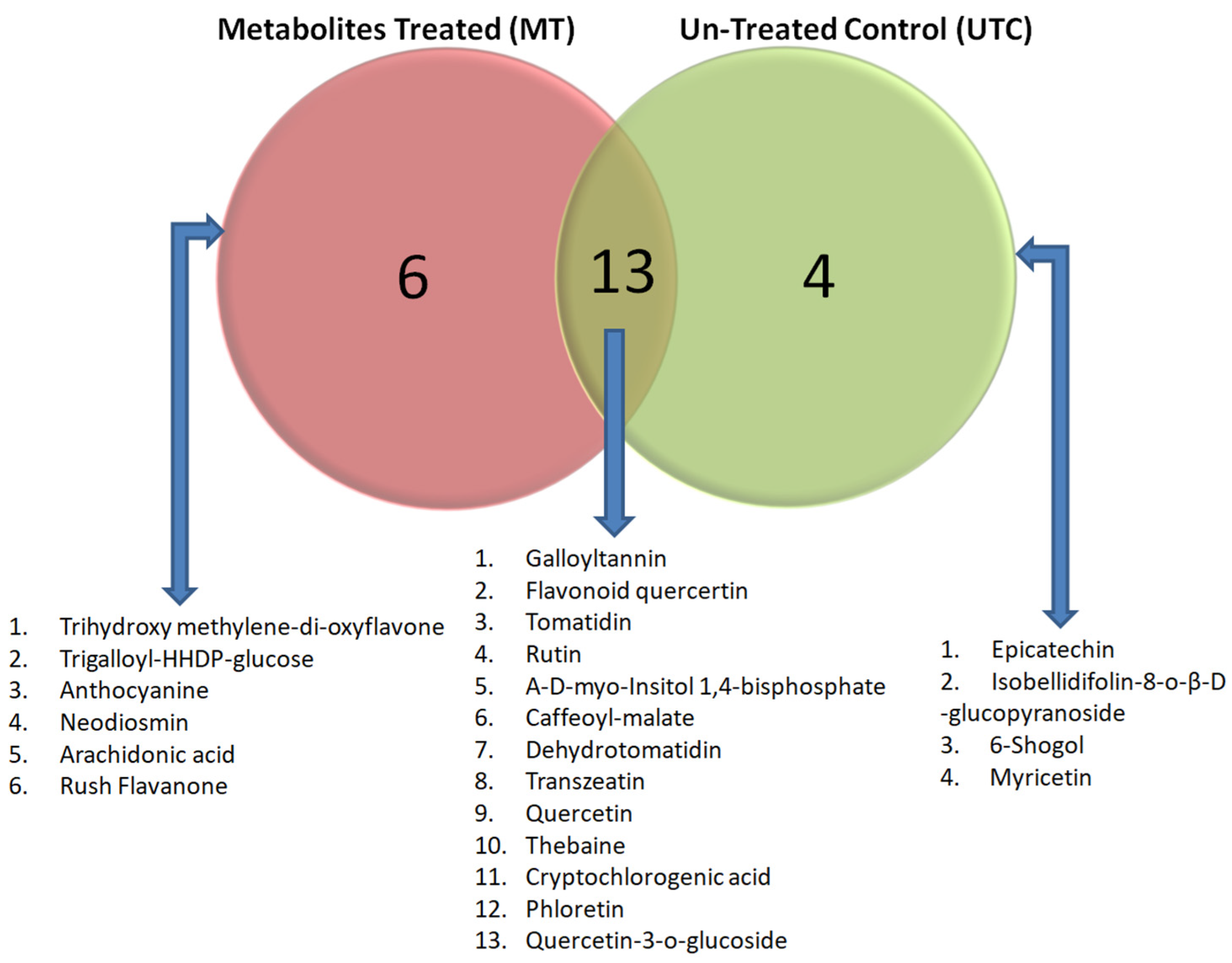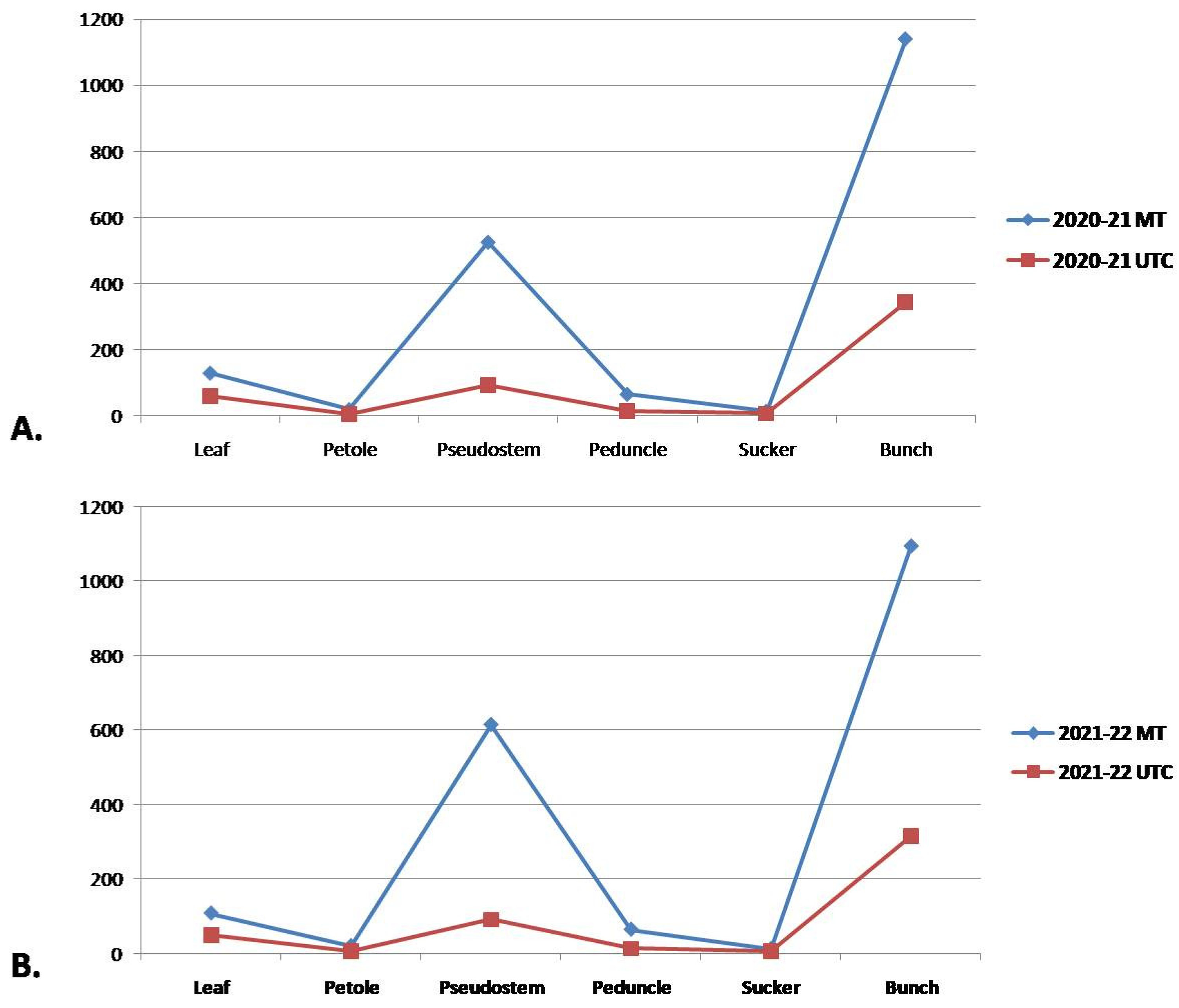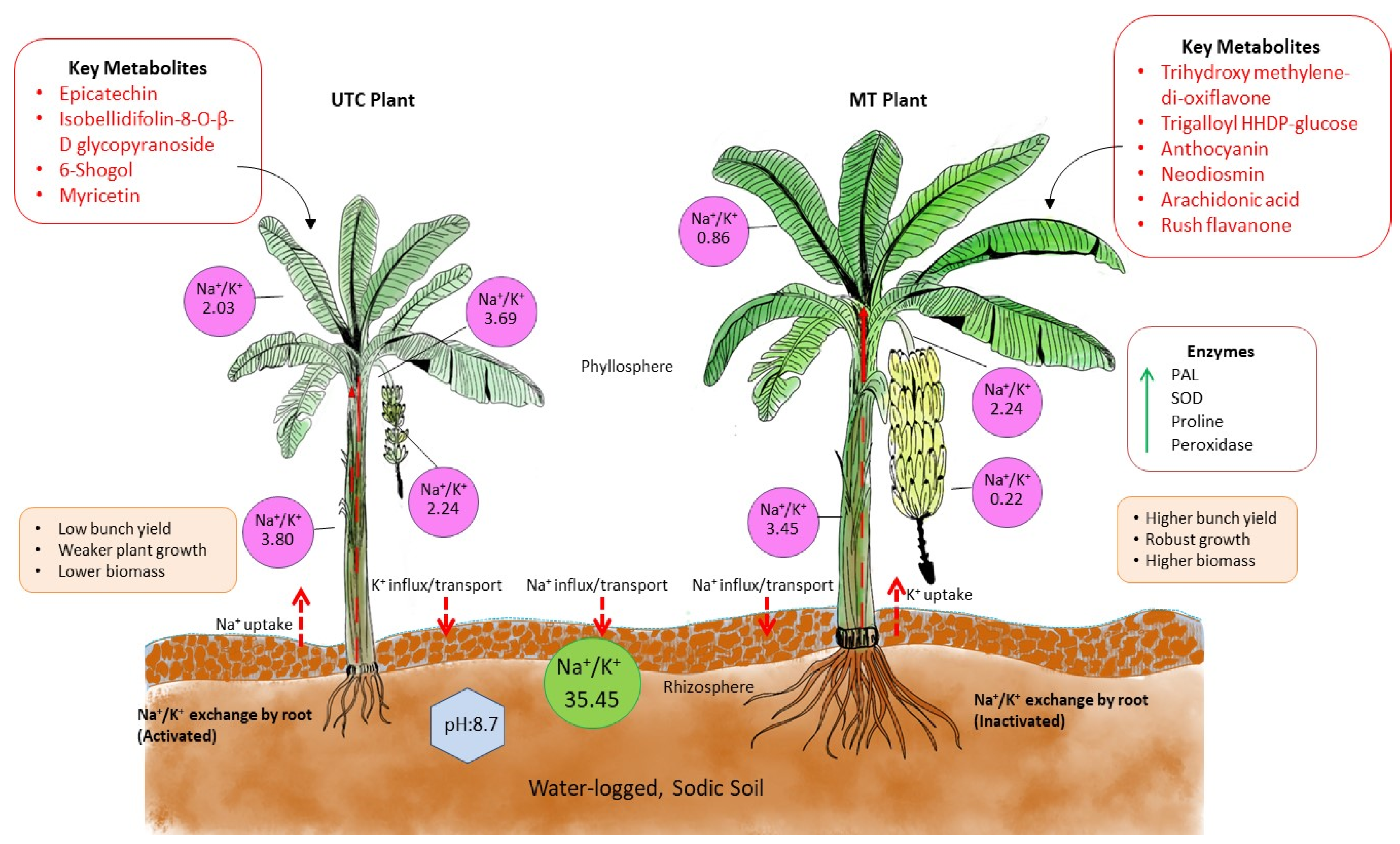Secondary Metabolite-Induced Osmo-Protection and Host Antioxidant Systems in Banana in Waterlogged Sodic Soils
Abstract
1. Introduction
2. Materials and Methods
2.1. Materials and Location of the Experiment
2.2. Soil Analysis of Micronutrients at the Experimental Location
2.3. Micronutrient Analysis of the Plant Tissues
2.4. Estimation of Stress Enzymes in MT-Immunized vs. Control Banana Leaves in Sodic Soils
2.5. LC-MS Analysis of MT-Immunized vs. Control Banana Leaves in Sodic Soils
2.6. Statistical Analysis
3. Results
3.1. Field Performance of MT Banana Plants Compared toUTC Plants
3.2. Assessment of Role of MT Plants in Na/K Uptake Based on Soil and Ca Homeostasis
3.3. Metabolic Profiling of Sodicity-Stressed MT Plants in Comparison with UTC
3.4. Profiling of Stress-Related Enzymes in MT vs. UTC
3.5. Performance of MT Plants in Sodic Soils in Terms of Biomass
3.6. Mechanism of Sodicity Tolerance
4. Discussion
5. Conclusions
Supplementary Materials
Author Contributions
Funding
Data Availability Statement
Acknowledgments
Conflicts of Interest
Abbreviations
| PGPR | Plant growth-promoting rhizobacterial |
| MT | Metabolite-treated |
| UTC | Untreated control |
| RBD | Randomized block design |
| EC | Electrical conductivity |
| PO | Peroxidase |
| PPO | Polyphenol oxidase |
| SOD | Super oxide dismutase |
| PAL | Phenylalanine ammonia lyase |
| LC-MS | Liquid chromatography coupled with mass spectrophotometry |
References
- Shrivastava, P.; Kumar, R. Soil salinity: A serious environmental issue and plant growth promoting bacteria as one of the tools for its alleviation. Saudi J. Biol. Sci. 2015, 2, 123–131. [Google Scholar] [CrossRef]
- Kumar, P.; Sharma, P.K. Soil salinity and food security in India. Front. Sustain. Food Syst. 2020, 4, 533781. [Google Scholar] [CrossRef]
- Mohanavelu, A.; Naganna, S.R.; Al-Ansari, N. Irrigation induced salinity and sodicity hazards on soil and groundwater: An overview of its causes, impacts and mitigation strategies. Agriculture 2021, 11, 983. [Google Scholar] [CrossRef]
- Mehrotra, N.K.; Agarwala, S.C. Micronutrients disorders associated with helomorphic soils of Uttar Pradesh. Indian J. Plant Nutr. 1987, 6, 51–81. [Google Scholar]
- Vinocur, B.; Altman, A. Recent advances in engineering plant tolerance to abiotic stress: Achievements and limitations. Curr. Opin. Biotechnol. 2005, 16, 123–132. [Google Scholar] [CrossRef]
- Roy, S.; Chowdhury, N. Salt Stress in plants and amelioration strategies: A critical review. In Abiotic Stress in Plants; Fahad, S., Saud, S., Chen, Y., Wu, C., Wang, D., Eds.; Intech Open: London, UK, 2021; Volume 1, pp. 391–422. [Google Scholar]
- Damodaran, T.; Rai, R.B.; Mishra, V.K.; Sharma, D.K.; Ram, R.A.; Rai, S.; Kumar, H. Integrated Farming System and Livelihood Security: An Approach; Central Soil Salinity Research Institute (CSSRI): Karnal, India, 2011; pp. 1–108. [Google Scholar]
- Qadir, M.; Oster, J.D. Vegetative bioremediation of calcareous sodic soils: History, mechanisms and evaluation. J. Irrig. Sci. 2002, 21, 91–101. [Google Scholar]
- Kashyap, S.; Agarwala, N.; Sunkar, R. Understanding plant stress memory traits can provide a way for sustainable agriculture. Plant Sci. 2024, 340, 111954. [Google Scholar] [CrossRef]
- Liu, H.; Able, A.J.; Able, J.A. Priming crops for future: Reviewing stress memory. Trends Plant Sci. 2022, 27, 699–716. [Google Scholar] [CrossRef]
- Harish, S.; Kavino, M.; Kumar, N.; Samiyappan, R. Bio-priming banana with plant growth-promoting Endophytic bacteria induces systemic resistance against banana bunchy top virus. Acta Hortic. 2009, 829, 295–302. [Google Scholar] [CrossRef]
- Murphy, J.F.; Reddy, M.S.; Ryu, C.M.; Kloepper, J.W.; Li, R. Rhizobacteria mediated growth promotion of tomato leads to protection against cucumber mosaic virus. Phytopathology 2003, 93, 1301–1307. [Google Scholar] [CrossRef]
- Yang, J.; Kloepper, J.W.; Ryu, C.M. Rhizosphere bacteria help plants tolerate abiotic stress. Trends Plant Sci. 2009, 14, 1–4. [Google Scholar] [CrossRef] [PubMed]
- Goellner, K.; Conrath, U. Priming: It’s all the world to induced disease resistance. Eur. J. Plant Pathol. 2008, 121, 233–242. [Google Scholar] [CrossRef]
- Mayak, S.; Tirosh, B.R. Plant growth promoting bacteria confer resistance in tomato plants to salt stress. Plant Physiol. Biochem. 2004, 42, 565–572. [Google Scholar] [CrossRef] [PubMed]
- Damodaran, T.; Jha, S.K.; Kumari, S.; Gupta, G.; Mishra, V.K.; Sharma, P.C.; Gopal, R.; Singh, A.; Jat, H.S. Development of halotolerant microbial consortia for salt stress mitigation and sustainable tomato production in sodic soils: An enzyme mechanism approach. Sustainability 2023, 15, 5186. [Google Scholar] [CrossRef]
- Damodaran, T.; Mishra, M.; Muthukumar, M.; Rajan, S.; Yadav, K.; Kumar, A.; Debnath, P.; Kumari, S.; Bora, P.; Gopal, R.; et al. Secondary metabolite induced tolerance to Fusarium oxysporum f. sp. cubense TR4 in banana cv. Grand Naine through in vitro bio-immunization: A prospective research translation from induction to field tolerance. Front. Microbiol. 2023, 14, 1233469. [Google Scholar] [CrossRef]
- Hinge, V.R.; Shaikh, I.M.; Chavhan, R.L.; Deshmukh, A.S.; Shelake, R.M.; Ghunge, S.A.; Dethe, A.M.; Suprasanna, P.; Kadam, U.S. Assessment of genetic diversity and volatile content of commercially grown banana (Musa spp.) cultivars. Sci. Rep. 2022, 12, 7979. [Google Scholar] [CrossRef]
- Jeyabaskaran, K.J. Studies on fixing critical limits of K, Na and K/Na ratio for bananas in saline sodic soil conditions. InfoMusa 2000, 9, 34. [Google Scholar]
- Chang, K.L.; Bray, R.H. Determination of calcium and magnesium in soil and plant material. Soil Sci. 1951, 72, 449–458. [Google Scholar] [CrossRef]
- Richards, L.A. Diagnosis and improvement of saline and alkali Soils. In USDA Handbook; Forgotten Books: London, UK, 1954; Volume 60. [Google Scholar]
- Hammerschmidt, R.; Nuckles, E.M.; Kuc, J. Association of enhanced peroxidase activity with induced systemic resistance of cucumber to Colletotrichum lagenarium. Physiol. Plant Pathol. 1982, 20, 73–82. [Google Scholar] [CrossRef]
- Mayer, A.M.; Harel, E. Polyphenol oxidases in plants. Phytochemistry 1979, 18, 193–215. [Google Scholar] [CrossRef]
- Constantine, N.G.; Stanley, K.R. Superoxide Dismutases: I. Occurrence in Higher Plants. Plant Physiol. 1977, 59, 309–314. [Google Scholar]
- Şirin, S.; Aydaş, S.B.; Aslım, B. Biochemical evaluation of phenylalanine ammonia lyase from endemic plant Cyathobasis fruticulosa (Bunge) Aellen. for the dietary treatment of Phenylketonuria. Food Technol. Biotechnol. 2016, 54, 296–303. [Google Scholar] [CrossRef]
- Bates, L.S.; Waldren, R.P.; Teare, I.D. Rapid determination of free proline for water-stress studies. Plant Soil 1973, 39, 205–207. [Google Scholar] [CrossRef]
- Brahmachari, G.; Jash, S.K.; Gangopadhyay, A.; Sarkar, S.; Laskar, S.; Gorai, D. Chemical constitution of Limnophila indica. Indian J. Chem. 2008, 47, 1898–1902. [Google Scholar]
- Lachowicz, S.; Oszmiański, J.; Rapak, A.; Ochmian, I. Profile and Content of Phenolic Compounds in Leaves, Flowers, Roots, and Stalks of Sanguisorba officinalis L. determined with the LC-DAD-ESI-QTOF-MS/MS analysis and their in vitro antioxidant, antidiabetic, antiproliferative potency. Pharmaceuticals 2020, 13, 191. [Google Scholar] [CrossRef]
- Damodaran, T.; Rajan, S.; Muthukumar, M.; Gopal, R.; Yadav, K.; Kumar, S.; Ahmad, I.; Kumari, N.; Mishra, V.K.; Jha, S.K. Biological Management of Banana Fusarium Wilt Caused by Fusarium oxysporum f. sp. Cubense Tropical Race 4 Using Antagonistic Fungal Isolate CSR-T-3 (Trichoderma reesei). Front. Microbiol 2020, 11, 595845. [Google Scholar]
- Mz Cloud. Advanced Mass Spectral Database. Available online: https://www.mzcloud.org/ (accessed on 24 February 2025).
- Lu, C.; Jiang, Y.; Yue, Y.; Sui, Y.; Hao, M.; Kang, X.; Wang, Q.; Chen, D.; Liu, B.; Yin, Z.; et al. Glutathione and neodiosmin feedback sustain plant immunity. J. Exp. Bot. 2022, 74, 976–990. [Google Scholar] [CrossRef]
- Savchenko, T.; Walley, J.W.; Chehab, E.W.; Xiao, Y.; Kaspi, R.; Pye, M.F.; Mohamed, M.E.; Lazarus, C.M.; Bostock, R.M.; Dehesh, K. Arachidonic acid: An evolutionarily conserved signaling molecule modulates plant stress signaling networks. Plant Cell. 2010, 22, 3193–3205. [Google Scholar] [CrossRef]
- Malikov, V.M.; Yuldashev, M.P. Phenolic Compounds of Plants of the Scutellaria L. Genus. Distribution, Structure, and Properties. Chem. Net. Copd. 2002, 38, 358–406. [Google Scholar]
- Ling, H.; Yang, H.; Tan, S.H.; Chui, W.K.; Chew, E.H. 6-Shogaol, an active constituent of ginger, inhibits breast cancer cell invasion by reducing matrix metalloproteinase-9 expression via blockade of nuclear factor-κB activation. Br. J. Pharmacol. 2010, 161, 1763–1777. [Google Scholar] [CrossRef]
- Jose, J.; Dhanya, A.; Haridas, K.R.; Kumar, T.S.; Jayaraman, S.; Variyar, E.J.; Sudhakaran, S. Structural characterization of a novel derivative of myricetin from Mimosa pudica as an anti-proliferative agent for the treatment of cancer. Biomed. Pharmacother. 2016, 84, 1067–1077. [Google Scholar]
- Magalhaes, L.M.; Ramos, I.I.; Reis, S.; Segundo, M.A. Antioxidant profile of commercial oenological tannins determined by multiple chemical assays. Aust. J. Grape Wine Res. 2014, 20, 72–79. [Google Scholar] [CrossRef]
- Singh, P.; Arif, Y.; Bajguz, A.; Hayat, S. The role of quercetin in plants. Pl. Physiol. Biochem. 2021, 166, 10–19. [Google Scholar] [CrossRef]
- Drapal, M.; Carvalho, E.B.D.; Rouard, M.; Amah, D.; Sardos, J.; Houwe, I.V.; Brown, A.; Roux, N.; Swennen, R.; Fraser, P.D. Metabolite profiling characterises chemotypes of Musa diploids and triploids at juvenile and pre-flowering growth stages. Sci. Rep. 2019, 9, 4657. [Google Scholar] [CrossRef] [PubMed]
- Kozukue, N.; Han, J.-S.; Lee, K.-R.; Friedman, M. Dehydrotomatine and α-tomatine content in tomato fruits and vegetative plant tissues. J. Agric. Food Chem. 2004, 52, 2079–2083. [Google Scholar] [CrossRef] [PubMed]
- Grobkinsky, D.K.; Edelsbrunner, K.; Pfeifhofer, H.; Graaff, E.V.; Roitsch, T. Cis- and trans-zeatin differentially modulate plant immunity. Plant Signal. Behav. 2013, 8, e24798. [Google Scholar] [CrossRef]
- Tok, T.T.; Gowder, S.J.T. Structural and pharmacological properties of alkaloids with special reference to thebaine type alkaloids. Biomed. J. Sci. Tech. Res. 2019, 17, 12767–12780. [Google Scholar]
- Pun, M.; Khazanov, N.; Galsurker, O.; Weitman, M.; Kerem, Z.; Senderowitz, H.; Yedidia, I. Phloretin, an Apple phytoalexin, affects the virulence and fitness of Pectobacterium brasiliense by interfering with Quorum-Sensing. Front. Pl. Sci. 2021, 12, 671807. [Google Scholar] [CrossRef]
- Nile, A.; Nile, S.H.; Shin, J.; Park, G.; Oh, J.W. Quercetin-3-Glucoside Extracted from Apple Pomace Induces Cell Cycle Arrest and Apoptosis by Increasing Intracellular ROS Levels. Int. J. Mol. Sci. 2021, 22, 10749. [Google Scholar] [CrossRef]
- Tiwari, H.S.; Agarwal, R.M.; Bhatt, R.K. Photosynthesis, stomatal resistance and related characteristics, as influenced by potassium under normal water supply and water stress conditions in rice (Oryza sativa L.). Indian J. Plant Physiol. 1998, 3, 314–316. [Google Scholar]
- Jatav, K.S.; Agarwal, R.M.; Tomar, N.S.; Tyagi, S.R. Nitrogen metabolism, growth and yield responses of wheat (Triticum aestivum L.) to restricted water supply and varying potassium treatments. J. Indian Bot. Sic. 2014, 93, 177–189. [Google Scholar]
- Ramegowda, V.; Senthil-kumar, M. The interactive effects of simultaneous biotic and abiotic stresses on plants: Mechanistic understanding from drought and pathogen combination. J. Plant Physiol. 2015, 176, 47–54. [Google Scholar] [CrossRef] [PubMed]
- Al-Karaki, G.N. Growth and mineral acquisition by mycorrhizal tomato under salt stress. Mycorrhiza 2000, 10, 51–54. [Google Scholar] [CrossRef]
- Li, J.; Yang, Y. How do plants maintain pH and ion homeostasis under saline-alkali stress? Front. Plant Sci. 2023, 14, 1217193. [Google Scholar] [CrossRef]
- Fracasso, A.; Trindade, L.; Amaducci, S. Drought tolerance strategies highlighted by two Sorghum bicolor races in a dry-down experiment. J. Plant Physiol. 2016, 190, 1–14. [Google Scholar] [CrossRef] [PubMed]
- Hareem, M.; Danish, S.; Obaid, S.A.; Ansari, M.J.; Datta, R. Mitigation of drought stress in chili plants (Capsicum annuum L.) using mango fruit waste biochar, fulvic acid and cobalt. Sci. Rep. 2024, 14, 14270. [Google Scholar] [CrossRef] [PubMed]
- Aslam, M.; Maqbool, M.A.; Cengiz, R. Drought Stress in Maize (Zea mays L.): Effects, Resistance Mechanisms, Global Achievements and Biological Strategies for Improvement; Springer: Cham, Switzerland, 2015; Volume 1, pp. 1–58. [Google Scholar]
- Kloepper, J.W.; Beauchamp, C.J. A review of issues related to measuring colonization of plant roots by bacteria. Can. J. Microbiol. 1992, 38, 1219–1232. [Google Scholar] [CrossRef]
- Joseph, B.; Patra, R.; Lawrence, R. Characterization of plant growth promoting rhizobacteria associated with chickpea (Cicer arieatinum L.). Int. J. Plant Prod. 2007, 2, 141–152. [Google Scholar]
- Egamberdieva, D.; Wirth, S.; Bellingrath-Kimura, S.D.; Mishra, J.; Arora, N.K. Salt-tolerant plant growth promoting rhizobacteria for enhancing crop productivity of saline soils. Front. Microbiol. 2019, 10, 2791. [Google Scholar] [CrossRef]
- Egamberdieva, D.; Shurigin, V.; Gopalakrishnan, S.; Sharma, R. Growth and symbiotic performance of chickpea (Cicer arietinum) cultivars under saline soil conditions. J. Biol. Chem. Res. 2014, 56, 1–10. [Google Scholar]
- Soussi, M.; Ocana, A.; Lluch, C. Effects of salt stress on growth, photosynthesis and nitrogen fixation in chick-pea (Cicer arietinum L.). J. Exp. Bot. 1998, 49, 1329–1337. [Google Scholar] [CrossRef]
- Abrar, M.M.; Sohail, M.; Saqib, M.; Akhtar, J.; Abbas, G.; Wahab, H.A.; Mumtaz, M.Z.; Mehmood, K.; Memon, M.S.; Sun, N.; et al. Interactive salinity and water stress severely reduced the growth, stress tolerance, and physiological responses of guava (Psidium guajava L.). Sci. Rep. 2022, 12, 18952. [Google Scholar] [CrossRef] [PubMed]
- Atta, K.; Mondal, S.; Gorai, S.; Singh, A.P.; Kumari, A.; Ghosh, T.; Roy, A.; Hembram, S.; Gaikwad, D.J.; Mondal, S.; et al. Impacts of salinity stress on crop plants: Improving salt tolerance through genetic and molecular dissection. Front. Plant Sci. 2023, 14, 1241736. [Google Scholar] [CrossRef] [PubMed]
- Ashraf, M.; Akram, N.A. Improving salinity tolerance of plants through conventional breeding and genetic engineering: An analytical comparison. Biotechnol. Adv. 2009, 27, 744–752. [Google Scholar] [CrossRef]
- Acosta-Motos, J.R.; Ortuño, M.F.; Bernal-Vicente, A.; Diaz-Vivancos, P.; Sanchez-Blanco, M.J.; Hernandez, J.A. Plant responses to salt stress: Adaptive mechanisms. Agronomy 2017, 7, 18. [Google Scholar] [CrossRef]
- Maathuis, F.J.M.; Amtmann, A. K+ nutrition and Na+ toxicity: The basis of cellular K+/Na+ ratios. Ann. Bot. 1999, 84, 123–133. [Google Scholar] [CrossRef]
- Wakeel, A. Potassium-sodium interactions in soil and plant under saline-sodic conditions. J. Plant Nutr. Soil Sci. 2013, 176, 344–354. [Google Scholar] [CrossRef]
- Assaha, D.V.M.; Ueda, A.; Saneoka, H.; Al-Yahyai, R.; Yaish, M.W. The Role of Na+ and K+ Transporters in salt stress adaptation in glycophytes. Front. Physiol. 2017, 8, 509. [Google Scholar] [CrossRef]
- Zhang, Y.; Fang, J.; Wu, X.; Dong, L. Na+ /K+ Balance and transport regulatory mechanisms in weedy and cultivated rice (Oryza sativa L.) under salt stress. BMC Plant Biol. 2018, 18, 375. [Google Scholar] [CrossRef]
- Li, J.; He, P.; Chen, J.; Hamad, A.A.A.; Dai, X.; Jin, Q.; Ding, S. Tomato performance and changes in soil chemistry in response to salinity and Na/Ca ratio of irrigation water. Agric. Water Manag. 2023, 285, 108363. [Google Scholar] [CrossRef]
- Ashraf, M.; Foolad, M.R. Roles of glycine betaine and proline in improving plant abiotic stress resistance. Environ. Exp. Bot. 2007, 59, 206–216. [Google Scholar] [CrossRef]
- Kaya, C.; Ashraf, M.; Dikilitas, M.; Tuna, A.L. Alleviation of salt stress-induced adverse effects on maize plants by exogenous application of indoleacetic acid (IAA) and inorganic nutrients—A field trial. Aust. J. Crop Sci. 2013, 7, 249–254. [Google Scholar]
- Mishra, P.; Sharma, P. Superoxide Dismutases (SODs) and their role in regulating abiotic stress induced oxidative stress in plants. In Reactive Oxygen, Nitrogen and Sulfur Species in Plants: Production, Metabolism, Signaling and Defense Mechanisms; Hasanuzzaman, M., Fotopoulos, V., Nahar, K., Fujita, M., Eds.; Wiley: Hoboken, NJ, USA, 2019; Volume 1, pp. 53–88. [Google Scholar]
- Ali, N.; Rafiq, R.; Nisa, Z.; Wijaya, L.; Ahmad, A.; Kaushik, P. Exogenous citric acid improves growth and yield by concerted modulation of antioxidant defense system in brinjal (Solanum melongena L.) under salt-stress. J. King Saud Univ. Sci. 2024, 36, 103012. [Google Scholar] [CrossRef]
- Gunasekaran, Y.; Thiyageshwari, S.; Ariyan, M.; Roy-Choudhury, A.; Park, J.H.; Selvi, D.; Chithra, L.; Anandham, R. Alleviation of sodic stress in rice by exploring the exo-polysaccharide producing sodic-tolerant bacteria. Agriculture 2022, 12, 1451. [Google Scholar] [CrossRef]
- Ganeshpurkar, A.; Saluja, A.K. The Pharmacological Potential of Rutin. Saudi Pharm. J. 2016, 25, 149–164. [Google Scholar] [CrossRef]
- Ismail, H.; Dragisic-Maksimovic, J.; Maksimovic, V.; Shabala, L.; Zivanovic, B.D.; Tian, Y.; Jacobsen, S.E.; Shabala, S. Rutin, a flavonoid with antioxidant activity, improves plant salinity tolerance by regulating K+ retention and Na+ exclusion from leaf mesophyll in quinoa and broad beans. Funct. Plant Biol. 2015, 43, 75–86. [Google Scholar] [CrossRef]
- Wahab, P.A.A.; Ahmad, A. Effects of exogenous arachidonic acid on morphological traits and fatty acid profile of rice (Oryza sativa L.) grown on saline soil. Univ. Malays. Teren. J. Undergrad. Res. 2019, 1, 68–78. [Google Scholar] [CrossRef]
- Gogna, M.; Choudhary, A.; Mishra, G.; Kapoor, R.; Bhatla, S.C. Changes in lipid composition in response to salt stress and its possible interaction with intracellular Na+-K+ ratio in sunflower (Helianthus annuus L.). Environ. Exp. Bot. 2020, 178, 104147. [Google Scholar] [CrossRef]
- Yan, K.; Cui, M.; Zhao, S.; Chen, X.; Tang, X. Salinity stress is beneficial to the accumulation of chlorogenic acids in honeysuckle (Lonicera japonica Thunb.). Front. Plant Sci. 2016, 7, 1563. [Google Scholar] [CrossRef]
- Schaller, H. Sterol and steroid biosynthesis and metabolism in plants and microorganisms. In Comprehensive Natural Products II; Lew, M., Hung-Wen, L., Eds.; Elsevier: Oxford, UK, 2010; Volume 1, pp. 755–787. [Google Scholar]
- Dey, A.; Mukherjee, A. Plant derived alkaloids: A promising window for neuroprotective drug discovery. In Discovery and Development of Neuroprotective Agents from Natural Products; Brahmachari, G., Ed.; Elsevier: Amsterdam, The Netherlands, 2018; Volume 1, pp. 237–320. [Google Scholar]
- Murofushi, N.; Yamane, H.; Sakagami, Y.; Imaseki, H.; Kamiya, Y.; Iwamura, H.; Hirai, N.; Tsuji, H.; Yokota, T.; Ueda, J. 8.02—Plant Hormones. In Comprehensive Natural Products Chemistry: Plant Hormones; Barton, S.D., Nakanishi, K., Meth-Cohn, O., Eds.; Elsevier: Oxford, UK, 1999; Volume 8, pp. 19–136. [Google Scholar]
- Anankanbil, S.; Pérez, B.; Cheng, W.; Ambrosio, G.G.; Zheng, G. Caffeoyl maleic fatty alcohol monoesters: Synthesis, characterization and antioxidant assessment. J. Colloid Interface Sci. 2019, 536, 399–407. [Google Scholar] [CrossRef]
- Gao, Y.; Jin, Y.; Guo, W.; Xue, Y.; Yu, L. Metabolic and physiological changes in the roots of two oat cultivars in response to complex saline-alkali stress. Front. Plant Sci. 2022, 13, 835414. [Google Scholar] [CrossRef] [PubMed]
- Khan, Z.; Shahwar, D. Role of Heat Shock Proteins (HSPs) and Heat Stress Tolerance in Crop Plants. In Sustainable Agriculture in the Era of Climate Change; Mirza, H., Roychowdhury, R., Srivastava, S., Choudhury, S., Eds.; Springer: Cham, Switzerland, 2020; Volume 1, pp. 211–234. [Google Scholar]






| Sl. No. | Soil Parameters | Values |
|---|---|---|
| 1. | Soil pH | 8.83 |
| 2. | Electrical conductivity (EC) | 0.326 dS m−1 |
| 3. | Sodium (Na+) | 13.21 meq L−1 |
| 4. | Potassium (K+) | 0.42 meq L−1 |
| 5. | Carbonate (CO3) | 2.01 meq L−1 |
| 6. | Bicarbonate (HCO3) | 3.0 meq L−1 |
| 7. | Chloride (Cl−) (meq/L) | 2.5 meq L−1 |
| 8. | Calcium, Ca (meq/L) | 1.0 meq L−1 |
| 9. | Magnesium, Mg (meq/L) | 1.5 meq L−1 |
| Year | Treatments | PH (cm) | PG (cm) | NL (nos.) | 3rd LL (cm) | 3rd LB | BW (kg) | NH/B | NF/H |
|---|---|---|---|---|---|---|---|---|---|
| 2021 | MT | 209.8 ± 8.31 | 53.2 ± 3.85 | 8.9 ± 1.20 | 219.6 ± 7.85 | 54.1 ± 4.23 | 21.1 ± 1.91 | 9.0 ± 1.33 | 16.0 ± 1.15 |
| UTC | 119.6 ± 7.76 | 32.8 ± 2.30 | 4.5 ± 0.53 | 172.5 ± 6.55 | 40.9 ± 2.77 | 8.3 ± 1.16 | 7.0 ± 0.67 | 11.2 ± 1.14 | |
| Fvalue | 629.075 * | 206.702 * | 113.143 * | 212.198 * | 68.240 * | 327.680 * | 18.00 * | 87.864 * | |
| 2022 | MT | 211.9 ± 10.69 | 52.4 ± 1.71 | 9.8 ± 0.79 | 214.5 ± 14.15 | 62.5 ± 5.80 | 20.6 ± 2.41 | 9.0 ± 0.94 | 14.9 ± 1.29 |
| UTC | 123.20 ± 8.51 | 35.10 ± 4.58 | 4.9 ± 1.20 | 176.1 ± 7.84 | 41.7 ± 4.14 | 9.0 ± 0.67 | 7.6 ± 0.84 | 11.9 ± 0.88 | |
| Fvalue | 421.358 * | 125.110 * | 116.805 * | 56.343 * | 85.227 * | 214.723 * | 12.250 * | 37.156 * | |
| Total | MT | 210.85 ± 9.38 | 52.8 ± 2.93 | 9.35 ± 1.09 | 217.05 ± 11.44 | 58.3 ± 6.55 | 20.85 ± 2.13 | 9.0 ± 1.12 | 15.45 ± 1.32 |
| UTC | 121.40 ± 8.14 | 33.95 ± 3.72 | 4.70 ± 0.92 | 174.30 ± 7.27 | 41.30 ± 3.45 | 8.65 ± 0.99 | 7.3 ± 0.80 | 11.55 ± 1.05 | |
| Fvalue | 1037.23 * | 316.843 * | 212.040 * | 198.924 * | 105.353 * | 538.147 * | 30.337 * | 107.232 * | |
| Treatments | Tentative Compound Identified | Peak Value (mz) | RT (min) | Intensity (%) | Tentative Activity | References |
|---|---|---|---|---|---|---|
| Unique Metabolites in MT | Trihydroxy methylene-di-oxyflavone | 611.3 | 5.85 | 78% | Antioxidant | [27] |
| Trigalloyl-HHDP-glucose | 635.5 | 28.58 | 100% | Phenolic compound | [28] | |
| Anthocyanin | 1192 | 9.45 | 100% | Antioxidant | [29] | |
| Neodiosmin | 608.3 | 18.96 | 8% | Induce-plant immunity | [30,31] | |
| Arachidonic acid | 441.4 | 27.98 | 10% | Phenolic compound | [32] | |
| Rushflavanone | 542.7 | 25.01 | 20% | Bioflavonoid | [30] | |
| Unique Metabolites in UTC | Epicatechin | 290.4 | 16.29 | 100% | Antioxidant | [30] |
| Isobellidifolin-8-O-β-D-glucopyranoside | 275.2 | 12.78 | 24 | Phenolic compound | [33] | |
| 6-Shogaol | 277.3 | 16.46 | 73% | Antioxidant | [34] | |
| Myricetin | 317.3 | 16.46 | 63% | Flavonoids | [35] | |
| Metabolites Expressed in both MT and UTC | Galloyltannin | 757.6 | 18.60 | 100% | Antioxidant | [36] |
| Flavonoid quercertin | 303.1 | 6.57 | 100% | Antioxidant | [37] | |
| Tomatidin | 415.3 | 17.89 | 100% | Glycoalkaloid | [30] | |
| Rutin | 609.4 | 20.29 | 100% | Antioxidant | [38] | |
| Caffeoyl-malate | 295.4 | 15.99 | 20% | Phenylpropanoid | [38] | |
| Dehydrotomatin | 1031.8 | 10.22 | 100% | Secondary metabolites | [39] | |
| Trans zeatin | 219.2 | 15.58 | 33% | Plant growth regulator | [30,40] | |
| Quercetin | 301.3 | 14.54 | 100% | Flavonoids (antioxidant) | [30,37] | |
| Thebaine | 311.3 | 16.04 | 100% | Alkaloids | [30,41] | |
| Cryptochlorogenic acid | 353.3 | 16.74 | 28% | Lignin biosynthesis | [38] | |
| Phloretin | 274.4 | 19.16 | 100 | Polyphenolic compound | [30,42] | |
| 6′-p-coumaroylglucoside | 609.4 | 20.25 | 100 | Flavonoids | [30] | |
| Quercetin-3-O-glucoside | 463.2 | 6.59 | 40% | Flavonoids | [43] |
Disclaimer/Publisher’s Note: The statements, opinions and data contained in all publications are solely those of the individual author(s) and contributor(s) and not of MDPI and/or the editor(s). MDPI and/or the editor(s) disclaim responsibility for any injury to people or property resulting from any ideas, methods, instructions or products referred to in the content. |
© 2025 by the authors. Licensee MDPI, Basel, Switzerland. This article is an open access article distributed under the terms and conditions of the Creative Commons Attribution (CC BY) license (https://creativecommons.org/licenses/by/4.0/).
Share and Cite
Thukkaram, D.; Manoharan, M.; Debnath, P.; Kumari, S.; Kumar, S.; Mishra, M.; Jha, S.K.; Verma, C.L. Secondary Metabolite-Induced Osmo-Protection and Host Antioxidant Systems in Banana in Waterlogged Sodic Soils. Horticulturae 2025, 11, 416. https://doi.org/10.3390/horticulturae11040416
Thukkaram D, Manoharan M, Debnath P, Kumari S, Kumar S, Mishra M, Jha SK, Verma CL. Secondary Metabolite-Induced Osmo-Protection and Host Antioxidant Systems in Banana in Waterlogged Sodic Soils. Horticulturae. 2025; 11(4):416. https://doi.org/10.3390/horticulturae11040416
Chicago/Turabian StyleThukkaram, Damodaran, Muthukumar Manoharan, Prasenjit Debnath, Sangeeta Kumari, Sandeep Kumar, Maneesh Mishra, Sunil Kumar Jha, and Chhedi L. Verma. 2025. "Secondary Metabolite-Induced Osmo-Protection and Host Antioxidant Systems in Banana in Waterlogged Sodic Soils" Horticulturae 11, no. 4: 416. https://doi.org/10.3390/horticulturae11040416
APA StyleThukkaram, D., Manoharan, M., Debnath, P., Kumari, S., Kumar, S., Mishra, M., Jha, S. K., & Verma, C. L. (2025). Secondary Metabolite-Induced Osmo-Protection and Host Antioxidant Systems in Banana in Waterlogged Sodic Soils. Horticulturae, 11(4), 416. https://doi.org/10.3390/horticulturae11040416







